
Arisaema is a large and diverse genus of the flowering plant family Araceae. The largest concentration of species is in China and Japan, with other species native to other parts of southern Asia as well as eastern and central Africa, Mexico and eastern North America. Asiatic species are often called cobra lilies, while western species are often called jack-in-the-pulpit; both names refer to the distinctive appearance of the flower, which consists of an erect central spadix rising from a spathe.
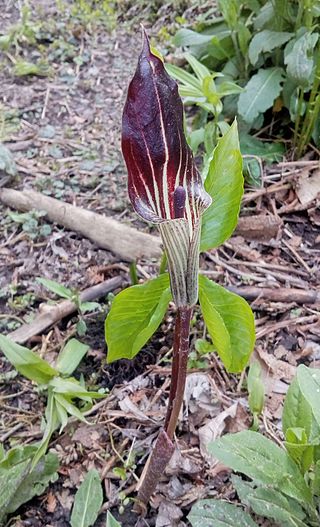
Arisaema triphyllum, the Jack-in-the-pulpit, is a species of flowering plant in the arum family Araceae. It is a member of the Arisaema triphyllum complex, a group of four or five closely related taxa in eastern North America. The specific name triphyllum means "three-leaved", a characteristic feature of the species, which is also referred to as Indian turnip, bog onion, and brown dragon.

Arisaema dracontium, the dragon-root or green dragon, is a herbaceous perennial plant in the genus Arisaema and the family Araceae. It is native to North America from Quebec through Minnesota south through Florida and Texas, where it is found growing in damp woods. It has also been reported from northeastern Mexico Plants grow 20–50 centimetres (7.9–19.7 in) tall when in bloom and after flowering reach 100 centimetres (39 in), and each grows from a corm. Normally, a plant produces one leaf with a long petiole, its leaf is composed of 7 to 13 leaflets, with its central leaflet being the largest one and with leaflets becoming smaller as they are produced distally, the leaflets are held out horizontally over the plant. During flowering in spring, a single slender, green spathe 3–6 centimetres (1.2–2.4 in) long is produced; it covers a tapering, long thin spadix. The tail-like spadix grows out around the top of its spathe. After flowering, up to 150 berries are produced in a club-shaped column. In late summer, the green berries turn orange-red, each berry produces 1 to 3 seeds. It is listed as a vulnerable species in Canada.
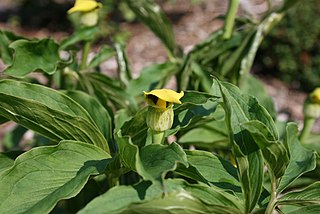
Arisaema flavum is a species of flowering plant widespread across north-eastern Africa and southern Asia. It is native to Ethiopia, Somalia, the Arabian Peninsula, Pakistan, Afghanistan, Nepal, Assam, Himalayas, Tibet, Yunnan, and Sichuan. The species epithet flavum is Latin for yellow and indicates its flower colour.

Oxalis glabra is a member of the wood-sorrel family, Oxalidaceae. It is only one of the 800 total species belonging to this family. The plant is commonly known as finger-leaf due to its trifoliate leaf structure. This trifoliate structure can be seen in variations throughout all members of the genus Oxalis. However, the particularly narrow leaflets of the glabra plant look more like fingers rather than a common clover. The plant is native to South Africa and can be found carpeting the ground of woodlands and bushlands.

Desmodium illinoense, the Illinois ticktrefoil, is a flowering plant in the bean family (Fabaceae), native to the central United States and Ontario, Canada. Illinois ticktrefoil grows in sunny places, such as prairies and oak savannas of the Great Plains and Great Lakes regions.
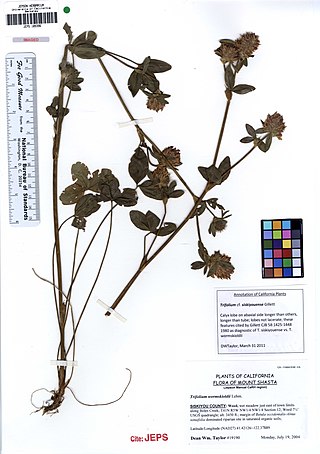
Trifolium siskiyouense, the Siskiyou clover, is a clover species endemic to the Klamath Mountains in the western United States.

Arisaema quinatum is a species of flowering plant in the arum family Araceae. It is a member of the Arisaema triphyllum complex, a group of closely related taxa in eastern North America. The specific name quinatum means "divided into five lobes", a reference to its characteristic leaves. It is commonly known as the southern Jack-in-the-pulpit but some refer to it as Preacher John.
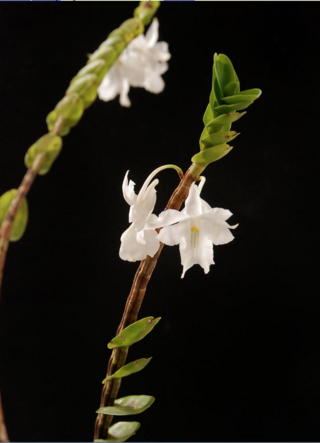
Dendrobium section Distichophyllae is a section of the genus Dendrobium.
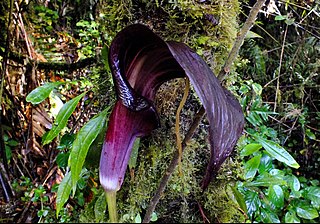
Arisaema section Anomala is a section of the genus Arisaema.
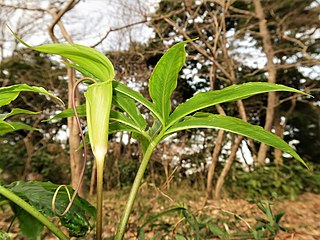
Arisaema section Clavata is a section of the genus Arisaema.
Arisaema decipiens is a species of plant native to China as well as India, Myanmar, and Vietnam. It grows in evergreen forest at elevations of 600–1,600 m (2,000–5,200 ft).
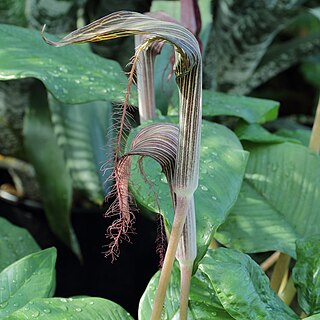
Arisaema fimbriatum is a species of Arisaema found in Thailand, Peninsular Malaysia, and Pulau Lankawi
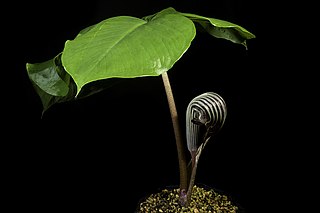
Arisaema section Franchetiana is a section of the genus Arisaema.

Arisaema section Tenuipistillata is a section of the genus Arisaema.

Arisaema section Nepenthoidea is a section of the genus Arisaema.

Arisaema section Attenuata is a section of the genus Arisaema found in tropical and subtropical habitats.
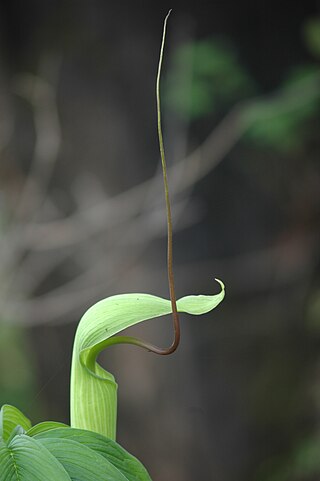
Arisaema section Tortuosa is a section of the genus Arisaema.

Arisaema section Sinarisaema is a section of the genus Arisaema.

Arisaema section Pistillata is a section of the genus Arisaema.























